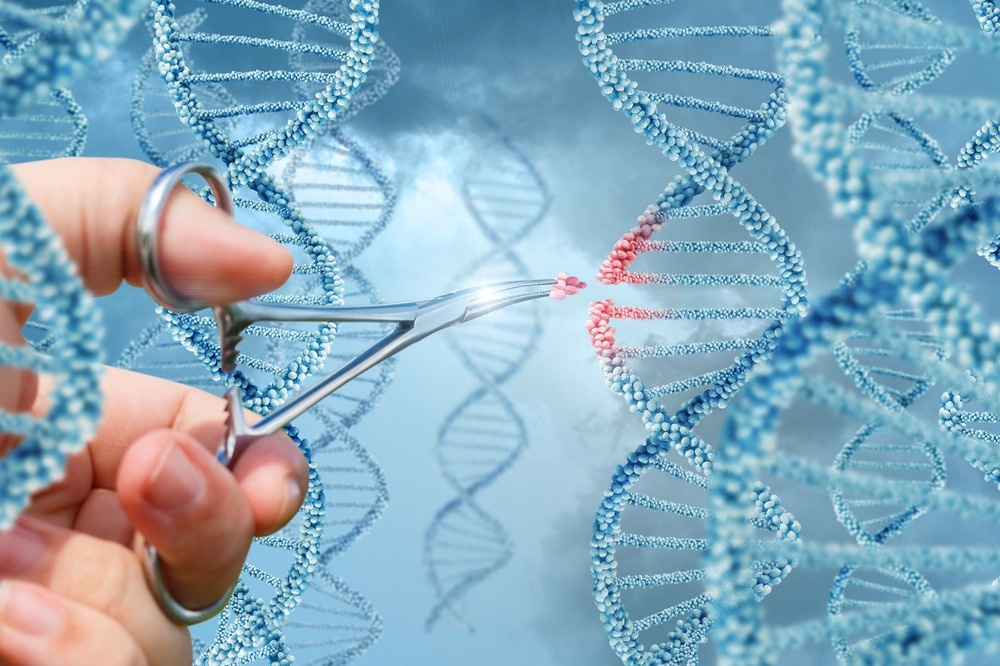The first simple production of customizable proteins known as zinc fingers to treat diseases by turning genes on and off might be enabled with the help of an artificial intelligence (AI) program.

Image Credit: Natali _ Mis/Shutterstock.com
At the NYU Grossman School of Medicine and the University of Toronto, scientists who developed the tool say it promises to expedite the development of gene therapies on a big scale.
Illnesses such as Tay-Sachs disease, sickle cell anemia, and cystic fibrosis are caused by errors in the order of DNA letters that tend to encode the operating instructions for each human cell. In a few instances, researchers can correct such mistakes along with gene-editing techniques that tend to rearrange such letters.
The cause of other conditions is not because of a mistake in the code itself, but by issues in how the cellular machinery reads DNA, a process known as epigenetics. A gene, which offers the recipe for a specific protein, often associates with molecules named transcription factors that notify the cell how much of that protein is to be created.
When this process goes wrong, over- or underactive genes are responsible for cancer, diabetes, and neurologic disorders. Consequently, scientists have been discovering methods for normal epigenetic activity to be restored.
One such method is zinc-finger editing, which could both control and change genes. Zinc fingers could direct DNA repair by catching onto scissor-like enzymes and directing them to cut incorrect segments out of the code among the amplest protein structures in the human body.
Likewise, zinc fingers can also catch onto transcription factors and pull them toward a gene segment that requires regulation. By tailoring such instructions, it is possible for genetic engineers to customize any gene’s activity.
But a disadvantage is that artificial zinc fingers are difficult to design for a particular task. As such proteins get fixed to DNA in complicated groups, scientists would need to be able to tell—out of innumerable likely combinations—how every zinc finger communicates with its neighbor for every preferred genetic change.
The study author’s new technology, named ZFDesign, defeats this hindrance by making use of AI to design and model such interactions. The model is founded on data produced by the screen of almost 50 billion possible zinc finger—DNA interactions in the scientists’ laboratories. A report on the tool was reported online on in the Nature Biotechnology journal on January 26th, 2023.
Our program can identify the right grouping of zinc fingers for any modification, making this type of gene editing faster than ever before.”
David Ichikawa, PhD, Study Lead Author and Former Graduate Student, NYU Langone Health
Dr Ichikawa notes that zinc-finger editing provides a possibly safer alternative to CRISPR, an important gene-editing technology having applications that vary from determining new methods to kill cancer cells to designing more nutritious crops.
Contrary to the completely human-derived zinc fingers, CRISPR, which refers to clustered frequently interspaced short palindromic repeat, depends on bacterial proteins to communicate with genetic code. These so-called “foreign” proteins could activate patients’ immune defense systems, which might attack them like any other infection and result in risky inflammation.
The authors of the study add that besides posing a reduced immune risk, the small size of zinc-finger tools might also offer highly flexible gene therapy methods than CRISPR by allowing more methods to deliver the tools to the correct cells in patients.
By speeding up zinc-finger design coupled with their smaller size, our system paves the way for using these proteins to control multiple genes at the same time. In the future, this approach may help correct diseases that have multiple genetic causes, such as heart disease, obesity, and many cases of autism.”
Marcus Noyes, PhD, Study Senior Author, NYU Langone Health
For the computer’s AI design code to be tested, Dr Noyes and his group made use of a customized zinc finger to interrupt the coding sequence of a gene in human cells. Besides, they constructed various zinc fingers that reprogrammed transcription factors in a successful manner to bind near a target gene sequence and turn up or down its expression. This illustrates that their technology could be utilized for epigenetic changes.
Dr Noyes, an assistant professor in the Department of Biochemistry and Molecular Pharmacology at NYU Langone, warns that, while hopeful, zinc fingers could be hard to control. As they are not always specific to a single gene, few combinations could impact DNA sequences beyond a specific target, resulting in accidental changes in a genetic code.
Consequently, Dr Noyes states that the team further plans to improve its AI program so it could build more accurate zinc-finger groupings that just induce the preferred edit. Also, Dr Noyes is a member of NYU Langone’s Institute for Systems Genetics.
The study was financially supported by National Institutes of Health grants R01GM118851 and R01GM133936. Additional funding was offered by the Canadian Institutes of Health Research Project grant PJT-159750, the Compute Canada Resource Allocation, the Frederick Banting and Charles Best Canada Graduate Scholarship, and the Ontario Graduate Scholarship.
Source:
Journal reference:
Ichikawa, D. M., et al. (2023) A universal deep-learning model for zinc finger design enables transcription factor reprogramming. Nature Biotechnology. doi.org/10.1038/s41587-022-01624-4